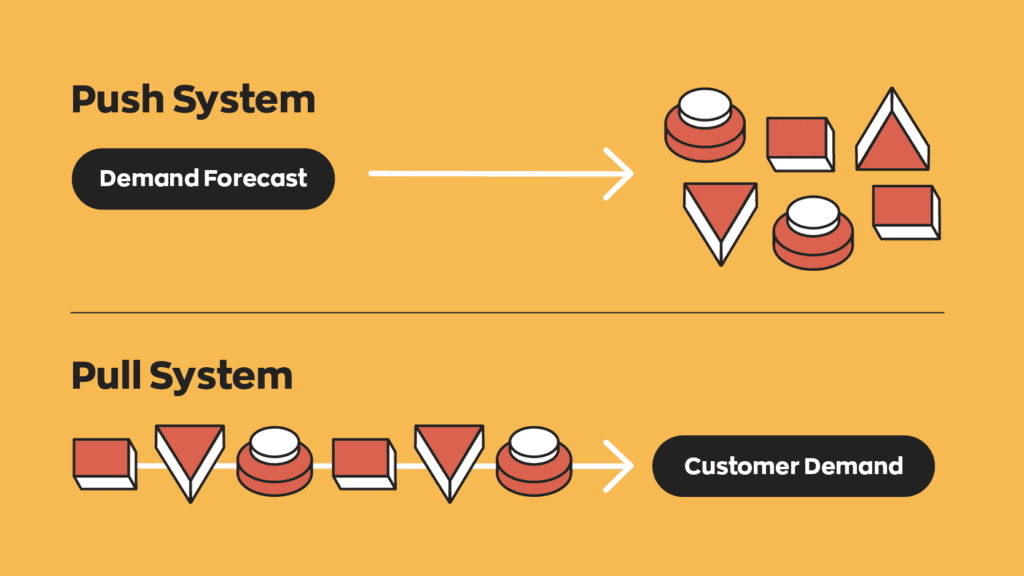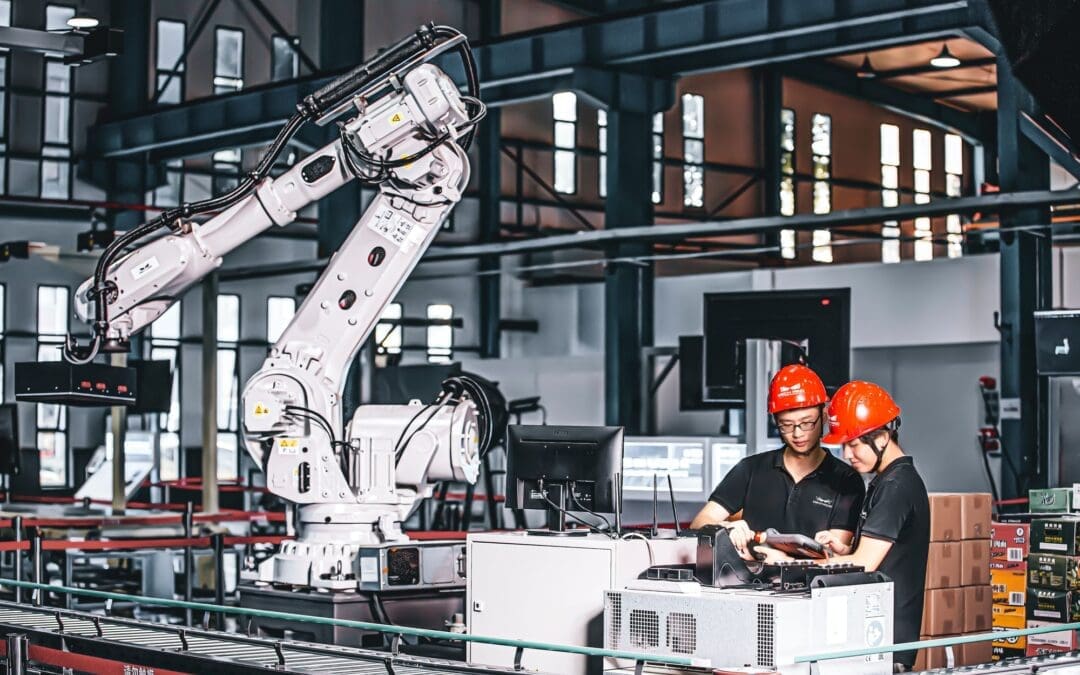Table of contents
What Are Push and Pull Systems?
Push and pull production systems in manufacturing management are an effective strategy. The system is a powerful tool for increasing the accuracy and efficiency of production. It is based upon the principles of Just-In-Time manufacturing (JIT). This is a system of production that delivers components and raw materials close to the production time.
The balance of the production process is achieved by using the push-pull system. The right materials and components are delivered at the right place and moment. This ensures materials are used efficiently and available at the right time.
What is a Push System?
In manufacturing, a push system means that the corporation produces things according to a projected demand. It is also called manufacturing to stock. This is used for commodities where there are few unanticipated changes in demand. It is common in the pharmaceuticals, food, and other sectors.
A push system will start production based on historical information to anticipate future demand. In this method, goods are “pushed” along the supply chain. Demand forecasts are used to initiate production. It also supervises the delivery to retailers or distributors of finished products. The retailers will sell the product and wait for the customer to purchase it.
The following points can be used to summarize the mechanism:
- Push systems are those that produce items based on actual customer demand.
- Production is not planned ahead.
- Production is actually triggered when the customer places an order.
- This production method requires a great deal of flexibility. The production can be switched between items quickly.

What is a Pull System?
Pull system is a lean manufacturing technique. This method produces products based on the actual demand, not expectations. This type of operation allows companies to store only the amount of inventory they need. The companies only create as much inventory as they need to meet existing orders.
Pull systems “pull” commodities through the supply chain. After a customer order triggers a series of events, the necessary amount of product is manufactured. The raw materials used in the manufacture of these products are then replenished.
Pull systems are a great example of Just-in-Time Manufacturing. JIT’s primary goal is to plan the process to ensure that the materials arrive exactly at the time the production begins. Production is planned to be completed at the exact time the goods are shipped.
Differentiating Between Pull and Push Systems
There are a few key differences that should be considered between the push and pull systems. The differences include:
Use
Push systems are used by companies to estimate the quantity of raw materials or supplies a manufacturer will need to meet the demand. This system relies on accurate predictions made by computer models that track costs, logistics, and the history of production processes. It is also called materials requirements planning and requires special software. The push systems can also determine when and where the greatest demand occurs. It can be a demand from a specific customer or based on yearly events, like the holiday shopping season.
Pull systems can also reduce waste and save money for both the manufacturer and retailer. To minimize waste, you need to control the flow of ingredients and raw materials. The formula for a pull system is usually:
- Order from the customer: The order includes the quantity ordered by the customer and the production deadline. Orders include customer specifications for every item or product.
- Acquisition of raw materials: Upon receiving an order from the company, the production facility will submit a request for raw materials to the supplier. The delivery time for raw materials varies, but in general, it takes a couple of days to a week to obtain.
- Production: Materials enable the manufacturer to finish the production process, and create the final product.
- Client feedback: Feedback from clients helps pull the system to optimize itself for cyclic order. Customers can create recurring orders, which may cause the shift from a pull system to a push system because manufacturers can predict future volume.
Stock on hand vs. On-Demand
Push system relies on the availability of sufficient inventory to meet demand. This algorithm is based on past orders and the amount of product that the company produces monthly or annually. The pull system orders inventory as required. Both systems are dependent on the customer’s orders. However, the pull system is more efficient because it only uses what is needed to create a certain amount of inventory.
The pull system allows for less error in timing. The manufacturer orders inventory only as needed, so any interruption in the supply chain could cause production to be delayed.
Work in Progress
Incomplete parts of the production or supply chain are referred to as work in progress (WIP). Pull systems don’t allow production to begin until all work in progress is completed. Push systems are a continuous work in progress and production continues regardless of the production amount.
Costs
Each system offers different cost-saving possibilities, depending on the volume of orders. Push systems allow manufacturers to buy raw materials and supplies at wholesale prices. This can be a cost-effective option for large manufacturers who rely on a high volume of orders every month or year. Pull systems reduce costs by reducing the inventory, which in turn can lower warehousing expenses for raw materials.
Scalability
Push systems are more scalable because the manufacturer can buy in bulk and meet the growing demand. Based on predictive algorithms manufacturers can scale up as orders grow without having to change the ordering system. Pull systems work better for small-scale environments, and it may be more difficult to scale a production style that uses just-in-time. Raw materials are delivered just before the order is placed.
Recalls
Recalling items may cause inventory to back up. The company may already have too many items in stock and will have to add recalled products to it. It can lead to a production backlog and increase the costs associated with a product recall. Pull system: A recall can create excess inventory. However, since the stock is not already in place, it will minimize the financial impact.
Labor demand
Push and pull systems have an impact on scheduling because it is affected by order volume. The predictive algorithm is used by push systems to predict and schedule costs. The manager can schedule additional labor when the predictions show a higher volume. A manufacturer using a pull system may find it difficult to meet a sudden increase in demand.

The Benefits of Using a Hybrid Push-Pull System
We will now look at the advantages of using a hybrid Push Pull System:
- Greater Efficiency: By combining push and pull production strategies, a hybrid push-pull push system can achieve greater efficiency. The system can therefore be used to manage inventory better. The system also manages delivery and production operations.
- Better Service Customers can enjoy faster response times with a hybrid system. Also, they can benefit from increased stock availability. It allows for better customer service and satisfaction.
- Reduced costs A hybrid push-pull can reduce the cost of storage, transportation, and inventory management. Businesses can increase profits and margins by reducing costs.
- Better Supply Chain Management A hybrid push-pull can improve supply chain management. This is done by improving forecasting, coordination, and planning. It can reduce lead times and increase stock availability.
- Improved Visibility A hybrid push-pull can increase visibility in the supply chain, allowing for better decisions. This can improve the efficiency of businesses and help them to improve their operations.



















